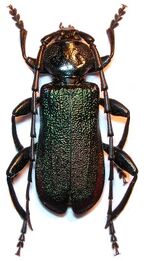Biology:Ropalopus insubricus
| Ropalopus insubricus | |
|---|---|

| |
| Scientific classification Error creating thumbnail: Unable to save thumbnail to destination
| |
| Domain: | Eukaryota |
| Kingdom: | Animalia |
| Phylum: | Arthropoda |
| Class: | Insecta |
| Order: | Coleoptera |
| Infraorder: | Cucujiformia |
| Family: | Cerambycidae |
| Genus: | Ropalopus |
| Species: | R. insubricus
|
| Binomial name | |
| Ropalopus insubricus Germar, 1824
| |
| Synonyms[1] | |
| |
Ropalopus insubricus is a rare species of European long-horned beetle in the family Cerambycidae.[1] It was first documented by Ernst Friedrich Germar in 1824 and first assessed for the IUCN Red List in 2009.[1][2] The species is quite rare in Europe and is classified as Near Threatened.[2]
Description
Ropalopus insubricus is a species within the genus Ropalopus. It is characterized by its distinct morphological features.[1] The species measures between 14 mm (0.55 in) and 31 mm (1.22 in) in length, it is identified by densely reticulated elytra lacking wrinkles in the basal half.[3][4] The pronotum is unevenly tapered, featuring a large rhomboid area with slight punctation.[4] In males, the lustrous pronotum contrasts with other subspecies, and the antennae are notably longer than the elytra.[4] Pronotum stains are characterized by deeper punctation, narrow irregularities, and a non-merging pattern.[4]
Female
Life cycle
The life cycle of the Ropalopus insubricus beetle species spans 2 to 3 years. Adult beetles emerge ready to fly between May and August.[5][6] The larvae of Ropalopus insubricus undergo development in damaged sections of living trees, pupating in the heartwoods under the bark.[2][4][6] Observed variations in the pronotum and elytra shape, as well as the distinct body coloration, within the same population are likely a result of larval development and pupation occurring under the bark and inside the wood of living trees, exposing the immature stages to different pressures.[4]
Distribution and habitat
Ropalopus insubricus, classified as an obligate saproxylic species, demonstrates a strong dependence on decaying wood throughout its life stages.[2] Preferring mountainous environments, this species is prevalent from northern Italy through Slovakia to Hungary and the Balkans, extending into westernmost Turkey.[2][4][7] Host trees, particularly broad-leaved species such as Acer, Ficus, Fraxinus, Alnus, and Fagus, play a crucial role in supporting the life cycle of this species.[2]
Ropalopus insubricus exhibits a degree of adaptability beyond montane habitats, as evidenced by its presence on road verges or Ficus plantations.[2] Suspected to require a warm climate at low altitude for optimal development, Ropalopus insubricus is distributed across more temperate regions of Europe.[2] Ropalopus insubricus can only be found at elevations lower than 600 meters (1968.5 feet) above sea level.[4]
Conservation status
Ropalopus insubricus is classified as Near Threatened on the IUCN Red List due to the rarity of the species.[2] Deforestation and forest fragmentation are contributing factors to its classification.[2]
References
- ↑ 1.0 1.1 1.2 1.3 Zicha, Ondrej. "BioLib: Biological library". https://www.biolib.cz/en/taxon/id170346/.
- ↑ 2.0 2.1 2.2 2.3 2.4 2.5 2.6 2.7 2.8 2.9 "Ropalopus insubricus". https://www.iucnredlist.org/species/157631/5112566.
- ↑ "Ropalopus ungaricus insubricus". http://www.cerambyx.uochb.cz/ropalopus_ungaricus_insubricus.php.
- ↑ 4.0 4.1 4.2 4.3 4.4 4.5 4.6 4.7 Karpinski, Lech; Szczepanski, Wojciech T.; Kruszelnicki, Lech (October 30, 2019). "Revision of the Ropalopus ungaricus/insubricus group (Coleoptera: Cerambycidae: Callidiini) from the western Palaearctic region". Zoological Journal of the Linnean Society 189 (4): 1176–1216. http://www.cerambyx.uochb.cz/assets/pdf/karpinski_et_al_2020_ropalopus_ungaricus_revision.pdf.
- ↑ "Ropalopus insubricus". http://cerambyx.uochb.cz/ropalopus_insubricus.php.
- ↑ 6.0 6.1 "Ropalopus insubricus (Germar, 1824) - Xylophagous Insects". https://www.forestpests.org/hungary/longhornri.html.
- ↑ Paleart, Cerambycidae of the. "Longhorn beetle - Cerambycinae - Callidiini - Ropalopus insubricus insubricus Germar, 1824" (in cs). http://www.cerambycidae.info/subfamily/cerambycinae/callidiini/ropalopus-insubricus-insubricus-germar-1824/.
External links
Wikidata ☰ Q14727479 entry
 |



